Keywords
|
| Active Power Filters, Hysteresis Band Current Control method ,Shunt Active Power Filter |
INTRODUCTION
|
| The use of the modern electronic equipments has changed our lives and has introduced wide variety of loads in the power systems[1]. This has changed the load characteristics of the electric supply networks, all the electronic loads are “nonlinear” (Current is not proportional to the applied voltage) and this is because of the way they draw the power from the supply[2]. The Non-linear loads will produce current and voltage components with higher frequencies into the power line. These higher frequencies of current and voltage components are known as the power harmonics. Even though a single lowpower electronic based appliance, in which a single-phase diode rectifier with a dc link capacitor is used as utility interface, produces a negligible amount of harmonic current. Three-phase diode or thyristor rectifiers and cycloconverters for industry applications also generate a large amount of harmonic current[3]-[4]. Voltage distortion or harmonics resulting from current harmonics produced by power electronic equipment has become a serious problem to be solved in many countries. “Harmonics are currents and voltages that are continuous multiples of the fundamental frequency of 50 Hz such as 100 Hz (2nd harmonic) and 250 Hz (5th harmonic)”. Most commonly used non-linear loads are Switch Mode Power Supply systems found in personal computers. Microwave ovens, laser printers, medical instrumentation systems, stereos, televisions, Adjustable speed drives, and electronic lighting are also examples of equipments using switch mode power supplies. Other types of non-linear loads include rectifiers, both controlled and uncontrolled, and phase angle controlled power supplies. |
| There are two approaches to mitigate the power quality problems. The first approach is called load conditioning, which ensure that the equipment is made less sensitive to the power disturbances, allowing the operation of equipments even under significant voltage distortion. The other solution is to install line-conditioning systems that suppress or counteract the power system disturbances. Power electronic equipment can be designed to provide harmonic free performance. But in most applications, the economic incentives have not been sufficient to bring about design improvements[6]. The sinusoidal nature of the power system voltage should be preserved, while protecting components from added harmonic loadings. The electrical utilities are quickly adopting the philosophy and constraints proposed in IEEE 519-1992, a recommended practice (one level short of a mandatory standard), limiting the both utility voltage and end-user current distortions. In order to maintain good power quality, various international agencies recommended limits of harmonic current injection into the utility..The amount of distortion in the voltage or current waveform is quantified by means of an index called the total harmonic distortion (THD). The THD in current is defined as |
 |
FUNCTIONING OF ACTIVE POWER FILTERS
|
| A single phase power supply with 230V, 50Hz, which is connected to a full bridge diode rectifier as the nonlinear load in this project to produce a distorted source current. Due to the nonlinear characteristic of the diodes, the sinusoidal current waveform for the supply is distorted. The distorted current is fed into the harmonics isolator to produce the desired compensated harmonic currents which is the inversed of the original harmonics in the line. The harmonics isolator algorithms are based on the instantaneous active and reactive theorem in time domain. |
HYSTERESIS CURRENT CONTROL
|
| The basic implementation of the hysteresis current controller derives the switching signals from the comparison of the current error with a fixed hysteresis band The operation of the hysteresis current controller is explained by circuit shown in fig 3 the load current components ia , ib are sensed and compared with the respective command current components iaref, ibref using two independent hysteresis comparators having hysteresis band H. The output error currents of comparator are used to active the inverter powers switches. The advantage of this controller lies its simplicity and its providing of excellent dynamic performance. Thus, it has most extensively used. On the other hand, the disadvantage is that the switching frequency varies during fundamental period, resulting in irregular operation of the inverter. As a result the switching losses are increased. |
| APF eliminates system harmonics through injecting a current to the system that is equal to the load harmonic current; therefore the system side will almost have no harmonic current remaining. Since the load harmonics to be compensated may be very complex and changing rapidly and randomly, APF has to respond quickly and work with high control accuracy in current tracking. Moreover in order to keep high safety and efficiency in APF operation, the required voltage source inverter (VSI) switching frequency and dc source voltage, which are highly relevant to the current tracking method used should as low as possible[1]-[2]. It is clear that APF output current control technique is the key issue of its performance and efficiency.. However switching frequency might fluctuate greatly .The latter can realize constant switching frequency but with relatively lower accuracy and response speed.Active filters produce a nearly sinusoidal supply current by measuring the harmonic currents and then injecting them back into the power system with a 180° phase shift. A controlled current inverter is required to generate this compensating current. Hysteresis current control is a method of controlling a voltage source inverter so that an output current is generated which follows a reference current waveform[3]- [4]. This method controls the switches in an inverter asynchronously to ramp the current through an inductor up and down so that it tracks a reference current signal. Hysteresis current control is the easiest control method to implement. |
| A hysteresis current controller is implemented with a closed loop control system. An error signal, e(t) is used to control the switches in an inverter. This error is the difference between the desired current, Iref (t), and the current being injected by the inverter, Iactual(t).When the error reaches an upper limit, the transistors are switched to force the current down. When the error reaches a lower limit the current is forced to increase. The range of the error signal directly controls the amount of ripple in the output current from the inverter and this is called the Hysteresis Band. The Hysteresis limits relate directly to an offset from the reference signal and are referred to as the Lower Hysteresis Limit and the Upper Hysteresis Limit. The current is forced to stay within these limits even while the reference current is changing. |
| The turn-on and turn-off conditions for the inverter switches is |
| • Upper switch Off: (iact – iref) > HB. |
| • Lower switch Off: (iact – iref) < -HB. |
| The width of the hysteresis band determines the switching frequency of the inverter. As the band - width narrows the switching frequency increases. A suitable bandwidth should be selected in accordance with the switching capability of the inverter[6]. The fixed hysteresis band is very simple and easy to implement. This high frequency produces a great stress for the switches and induces important switching losses. When the inductance is too large the maximum rate of change of current will be too low to track the steep current changes that occur with high frequencies. The small inductances used mean that the rates of change of current will be high. High switching frequencies result and this causes large losses in the semiconductor switches[5]. This also leads to increased levels of electromagnetic interference and requires very high-speed comparisons of the actual current against the hysteresis limits. |
| 3.1 Adaptive hysteresis band calculator |
| A novel adaptive-hysteresis (nearly) constant-frequency current control technique for single-phase switchmode rectifiers operating in continuous conduction mode is presented. It is based on cycle-by-cycle hysteresis calculator, which generates the hysteresis window that will keep the switching frequency in a very narrow band centered around programmed average value. |
| Adaptive hysteresis band calculator varies the hysteresis band width, HB, according to diref*(t)/dt and Vdc and supply voltage Vs. The analytical derivation is given below indicates that by variation in HB, switching frequency (fsw), can be maintained nearly constant. When the current in the injection inductor tries to leave the hysteresis band appropriate switch is turned ON or OFF to force the ramping of the current within the hysteresis band. |
| In the intervals t1 and t2 ia+ and ia- can be expressed as The slope of the reference current, DC link voltage, the source voltage and the inductance value are definite in this equation. By choosing an arbitrary switching frequency, so that fsw remains constant. |
| The turn-on and turn-off conditions for the inverter switches is |
| • Upper switch ON and Lower switch OFF: (i*ref - iactual) ≤ HB. |
| • Upper switch OFF and Lower switch ON: (i*ref - iactual) ≤ HB. |
SIMULATION RESULTS
|
4.2 USING ADAPTIVE HYSTERESIS CONTROLLER
|
| The simulink model of the system used for simulating the adaptive Hysteresis control is shown in the Fig 6 and simulink models of three main subsystems used for simulating reference current calculator adaptive hysteresis band calculator and inverter switching pulses are shown in Fig 7, Fig8 and Fig9 respectively. The solver used is ode23tb (stiff/TR-BDF2) and simulated in discrete-time domain with the system sampling time at 1us. The system parameters are shown in Table 1. |
| (i) Reference Current Control Algorithm Implementation: |
| The reference current control algorithm generates compensation currents for the single-phase shunt active power filter based on the sampling and integration of one complete power cycle. The PLL is used to generate the unit amplitude pure sin wave, multiplier gives the product of unit sin wave and the load current. The output of the multiplier is given to the resettable Integrator. The result is integrated for cycle duration and the value of integration is noted by a sample & hold mechanism at the end of cycle period. After sampling the integrator is reset and allowed to perform the integration for the next period. To reset the resettable integrator and sample & hold pulses aregenerated by using the Zero crossing detectors are shown in Fig 10.. The output of the multiplier is fundamental active component of the load current. This is subtracted from the load current to get the compensating current. |
| The D.C voltage across the capacitor is sensed and compared with reference it produces the error voltage. The error voltage is given to the proportional plus integral controller (PI) to get the peak value of charging current Isc, required to be absorbed by APF to charge the capacitor. The result is multiplied by unit sin wave to get the Instantaneous current[9]. By adding the instantaneous current and compensating current we will get the reference current. |
| (ii) Adaptive Hysteresis Band Implementation: |
| Adaptive hysteresis band calculator varies the hysteresis band width, HB, according to slope of the reference current diref*(t)/dt , Vdc and supply voltage Vs to maintain the switching frequency fsw nearly constant. The simulink model was developed by using following equation |
 |
Where  (slope of the reference current) (slope of the reference current) |
| (iii) Inverter Switching Logic Implementation: |
| The switching logic for the inverter IGBT Bridge by using S-R flip-flop as shown in the Fig 7.7.The turn-on and turn-off conditions for the inverter switches is |
| • Upper switch ON and Lower switch OFF: (i*ref - iactual) ≤ HB. |
| • Upper switch OFF and Lower switch ON: (i*ref - iactual) ≥ HB. |
| To implement the above conditions S-R flip-flop was used. These generated pulses are applied to the switching devices of the Voltage Source Inverter. |
MATLAB SIMULINK RESULTSAND DISCUSSIONS
|
| The system shown in fig14 is simulated for 1sec. Results are shown from 0.1 to 0.3 sec.The results of test systems are shown below |
| 5.1 WITHOUT CONTROLLER |
| We can observe that without using any controller the THD on source side has 24.47% |
| 5.2 RESULTS OF ACTIVE POWER FILTER WITH HYSTERESIS CONTROLLER |
| The system shown in fig 13 is simulated for 1sec. Results are shown from 0.1 to 0.3 sec. Fig 14, Fig 15and Fig 16 shows source current, load current and inverter injecting currents (actual current measured) respectively. Fig 17 and Fig 18 shows DC bus voltage and Source voltage & currents respectively. Fig19 and Fig 20 shows harmonic spectrums of source and load currents[8]. We can observe that THD on source side has reduced from 24.47% to 5.32%. Thus results show APF with conventional control effectively compensates both harmonic and reactive powers. |
| 5.3 RESULTS OF POWER FILTER WITH ADAPTIVE HYSTERESIS CONTROLLER |
| Test system shown in Fig 15 is simulated for 1 sec. Results are shown from 0.1 to 0.3 sec. Fig 24, Fig 25, Fig 26 and Fig 27 shows source current, load current, harmonic injecting current and DC bus voltages respectively. Fig 19 shows the source voltage and source current; clearly indicate that source current is in phase with the supply voltage. Fig 16 and Fig 17shows the harmonic spectrums of the load current and source current respectively. Fig 16 shows the inverter switching frequency[10]. We can observe that THD on source side has reduced from 24.47% to 4.21%. Thus results show APF with adaptive hysteresis control effectively compensates both harmonic and reactive powers. The switching frequency is also maintained nearly constant and also maintaining the merits of the conventional technique. |
CONCLUSION
|
| From the simulation responses, it is evident that the reference current generator and the adaptive hysteresis band current controller are performed satisfactorily. This work involves a simple technique based on sampling and integration of the normalized power signal over one power cycle period to determine the peak fundamental active component of the load current. The adaptive hysteresis band calculator dynamically adjusts the hysteresis bandwidth with the objective of constant device switching frequency. The source current waveform is in phase with the utility voltage and free from harmonic components. The single-phase shunt active power filter system has been implemented by using analog circuits. The reference current generator performed satisfactorily. In the open loop, Adaptive hysteresis band current controller is performed satisfactorily. The pulses are generated, isolated and amplified. |
| 6.1 FUTURE SCOPE OF WORK |
| Neural network or fuzzy logic based controllers can be incorporated for rating reduction and better response of the active filtering system.By limiting the high starting current of the filter and by implementing the precise blanking period (dead time) single-phase shunt active power filter system can be implemented perfectly. The active filtering system can also be implemented for three phase supply system configurations. |
| |
Figures at a glance
|
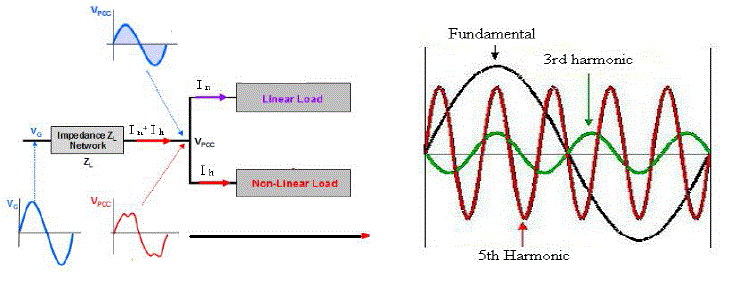 |
 |
 |
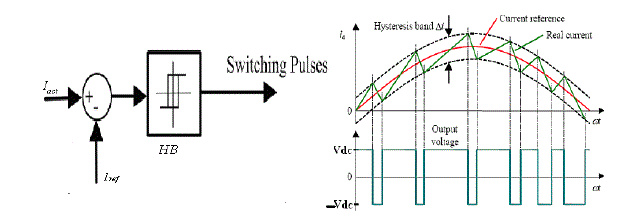 |
 |
| Figure 1 |
Figure 2 |
Figure 3 |
Figure 4 |
Figure 5 |
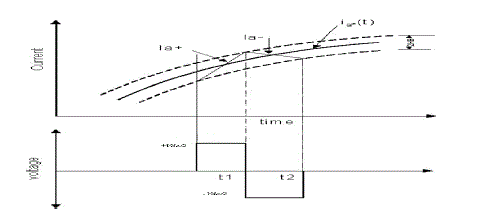 |
 |
 |
 |
 |
| Figure 6 |
Figure 7 |
Figure 8 |
Figure 9 |
Figure 10 |
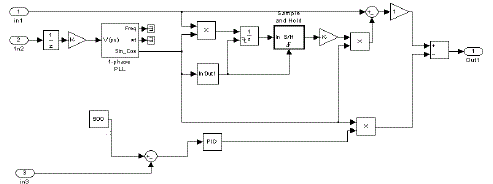 |
 |
 |
 |
 |
| Figure 11 |
Figure 12 |
Figure 13 |
Figure 14 |
Figure 15 |
 |
 |
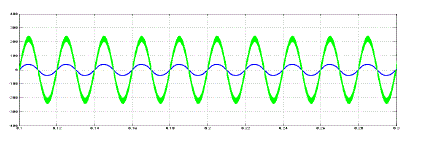 |
 |
 |
| Figure 16 |
Figure 17 |
Figure 18 |
Figure 19 |
Figure 20 |
 |
 |
 |
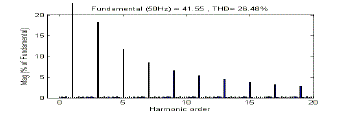 |
 |
| Figure 21 |
Figure 22 |
Figure 23 |
Figure 24 |
Figure 25 |
|
| |
References
|
- Akagi,H., “Active Harmonic Filters,” Proc.Of IEEE, Vol.93, No 12, pp.2128-2141., Dec 2005.
- Akagi, H., "New Trends In Active Filters For Improving Power Quality," Proceedings Of International Conference on Power Electronics, Drives and Energy Systems for Industrial Growth Vol. 1, pp. 417 - 425, January 1996
- Hsu, C.Y.; Wu, H.Y. "New Single-Phase Active Power Filter With Reduced Energy-Storage Capacity," IEEE Proceedings- Electric Power Applications, Vol 143, pp.25 - 30, January 1996.
- You ,Xiaojie; Li ,Yongdong "A Shunt Active Power Filter Using Dead-Beat Current Control, " proc. Of IEEE 2002 28th Annual Conference of the Industrial Electronics Society, vol. 1, pp. 633 - 637, November 2002.
- Meo, S.; Perfetto, A "Comparison of different control techniques for active filter applications," Proceedings of the Fourth IEEE International Caracas Conference on Devices, Circuits and Systems, P016-1 - P016-6, April 2002.
- Buso, S. et. al. “A Dead-Beat Adaptive Hysteresis Current Control, ” IEEE transaction on Industry Appliances, Vol. 36, pp.1174-1180, July- Aug. 2000
- Bose, B., K., "An Adaptive Hysteresis-Band Current Control Technique of a Voltage-Fed PWM Inverter for Machine Drive System,"IEEE Transactions On Industrial Electronics, Vol. 31, No. 5,pp 402-408, October 1990.
- Simone Buso, Luigi Malesani and Paolo Mattavelli “Comparison of Current Control Techniques for Active Filter Applications” IEEE Transcations on industrial electronics , vol 45, no. 5, October 1998.
- B.ChittiBabu and BathulaVasantha Reddy “An Improved Dynamic Response of Voltage Source Inverter using Novel Hysteresis Dead Band Current Controller” 18th annual symposium on emerging needs in computing, communication, signals and power-2009, 29th august , 2009.
- MirjanaMilo·sevic“Hysteresis Current Control in Three-Phase Voltage Source Inverter”
|